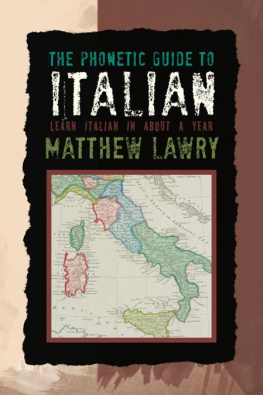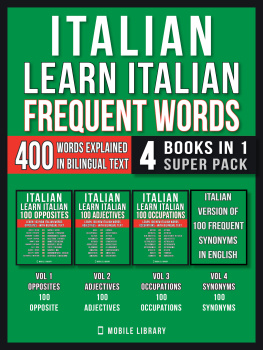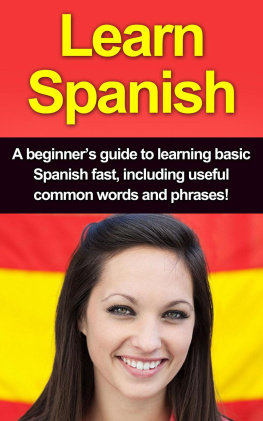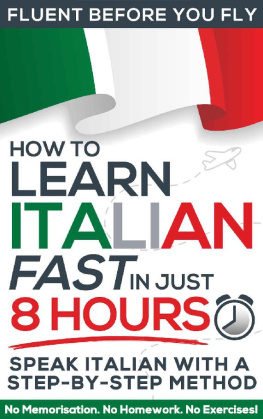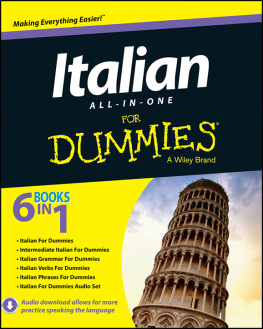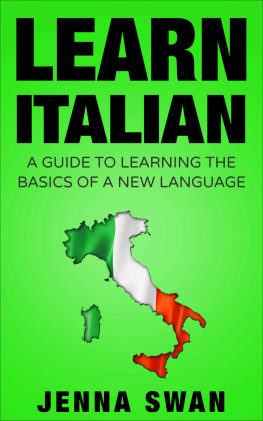The Phonetic Guide to
Italian
Learn Italian in about a year
Matthew Lawry

AuthorHouse
1663 Liberty Drive
Bloomington, IN 47403
www.authorhouse.com
Phone: 1-800-839-8640
2012 by Matthew Lawry. All rights reserved.
No part of this book may be reproduced, stored in a retrieval system, or transmitted by any means without the written permission of the author.
Published by AuthorHouse 07/23/2012
ISBN: 978-1-4772-1928-7 (sc)
ISBN: 978-1-4772-1929-4 (hc)
ISBN: 978-1-4772-1927-0 (e)
Any people depicted in stock imagery provided by Thinkstock are models, and such images are being used for illustrative purposes only.
Certain stock imagery Thinkstock.
Because of the dynamic nature of the Internet, any web addresses or links contained in this book may have changed since publication and may no longer be valid. The views expressed in this work are solely those of the author and do not necessarily reflect the views of the publisher, and the publisher hereby disclaims any responsibility for them.
Contents
I thought I would write a book that would give the reader the basic rudiments to learning and get rid of the problems that I faced and help people learn Italian the easiest way possible.
Most people learn Italian in which one of the first steps of learning is to learn the alphabet, but I feel that learning Italian through phrases in an associative way and leaving the more complicated sides to learning, after getting the basic language learnt.
In this book you will learn the language by going through the phrases, speaking them to yourself and learning them in a direct and logical way, although obviously in life you only get what you put in.
The first couple of chapters are going to be about learning greetings and general knowledge about people. The next chapters I will go into what I call Primary similarities and Secondary similarities, which are ways to help us glean learning through association. Primary similarity is a word that roughly means the same in Italian as in English; like capacit which is capacity, where as Secondary similarity is an Italian word that you can learn and is not quite as straight forward such as questione which means matter or issue, so you can remember it by relating it to an English word.
The book is about 520 pages long so you can get a wide understanding in about a year if you read two pages in an average day.
This book is designed for associative learning so then it is not so hard to take in, but obviously, you still have to apply yourself and repeat the words and phrases and sentences which do not necessarily stay in your memory.
All the phrases will be written down phonetically so then you can learn the pronunciation more easily.
I hope you enjoy this book.
I have decided to write a book about the Italian language to iron out any problems that I found while studying the language, such as even remembering basic phrases. I found that grouping phrases together for instance is a great help so I have decided to put words and sentences that are connected together.
It took me ages to get to grips with it, because we have such a fast life; you do not necessarily have the time to learn it in the text book way. I have put the alphabet at the end of the situational phase of the book the reason for that is; you can then concentrate on the learning of the words and pronunciation without coming up to learning blocks which make you feel like giving up.
This book is designed to help you have fun in expressing the language and guide you through from general phrases to the more complicated sentences.
At the beginning of the book I have put a glossary of pronouns and prepositions, so then you can check why they use certain grammar to form sentences: even though; you could learn it proficiently without looking at them. (Only use the prepositions and pronouns as a guide)
I wrote this book from the point of view of how people that speak English would find it easiest to learn, so thats why I have put less emphasis on the Italian alphabet and more emphasis on phonetics.
This book will go from general easy phrases to more difficult ones. You can also skip certain sections depending on how advanced you are. However, all the chapters will be dealt with in a very in-depth way so it will be worth checking out each section. You will notice I have not used full stops, exclamation marks or question marks on the phrases because you can tell whether it is a question such as: Would you like a drink which is Prende qualcosa da bere?
(This section is just for guide purposes)
IL GLOSSARIO
This is just a quick section to show you the reasons why they put certain words in sentences. I have written these so then if you are not sure what sort of grammar it is you can have a quick look at this glossary.
Il:Is a masculine and a definitive article and means the, which comes before masculine singular nouns for instance, Il cavalo which means the horse.
La:Is feminine and a definitive article and means the, which comes before a feminine singular noun for instance, La casa which means the house.
Lo:Is a masculine and a definitive article and means the, which comes before masculine singular nouns for instance when you use +z, gn, pn, ps, x, and s+consonant.
Un:Is a masculine indefinite article and means a or an for instance, Un delfino which means a dolphin.
Una:Is a feminine indefinite article and means a or an for instance, Una vespa which means a wasp.
Uno:Is a masculine indefinite article and means a or an and is used when you use +z, gn, pn, and s+consonant.
Lei:Is a singular pronoun and is used after a preposition or in a comparison and means her or she for instance Lei non lo sa which means she doesnt know.
Lui:Is a singular pronoun and is used after a preposition or in a comparison and means he or him.
Io:Is a singular pronoun for instance, Jeff e io which means Jeff and I and can mean Me if it is put at the front of a sentence.
S:Is a reflexive pronoun for instance Va da s che which means Its obvious that or Chi fa da s fa per tre which means If you want something done well or properly do it yourself and Un uomo che s fatto da s which means A self made man.
Te:Is a singular pronoun and it means you for instance Questo regalo per te which means This present is for you and beata te which means Lucky you. (When stressed)
Ti:Is a singular pronoun and it means you for instance and it means you Ti telefono domani which means Ill call you tomorrow. (When unstressed)
Voi:Is a masculine and feminine plural pronoun and it means you for instance Voglio vedere voi, non loro which means I want to see you, not them.
Loro:Is a masculine and feminine plural pronoun and it means They or Them for instance Voi lavorate sodo mentre loro si divertono which means You work hard while they have a good time and Lo dar a loro which means I will give it to them.
Suo/a:Is an adjective plural for his or her for instance Sua nonna e suo nonno which means her grandmother and grandfather or I suoi libri which means his her books but if it a female noun for instance La sua borsetta which means her handbag and male noun for instance Il suo moto which means his motorbike.
Tuo/a:Is an adjective singular for your e.g Tuo padre e tua madre which means Your father and your mother and for instance i tuoi which means your family.
Vostro Is an adjective plural for your e.g Vostra figlia which means
/a:Your daughter and La vostra casa which means your home for instance vostra quella casa which means is that house yours.
E/Ed Is a conjunction which means and for instance e is used e.g e Offerta e domanda which means Supply and demand and for instance Il riscaldamento dellatmosfera terrestre ed leffetto serra which means the The global warming and the greenhouse effect.
Next page
